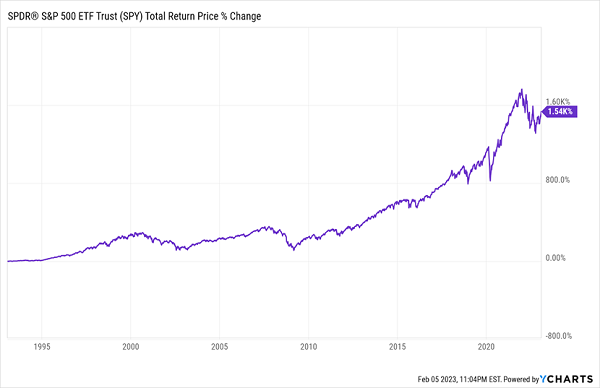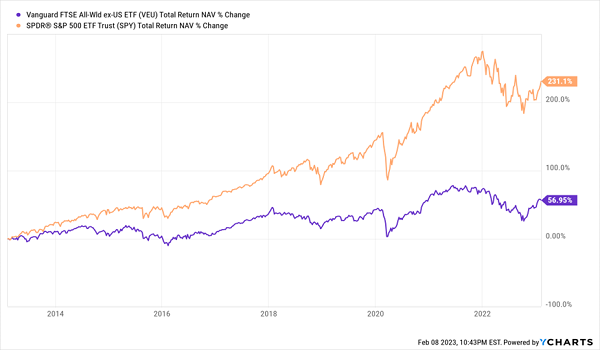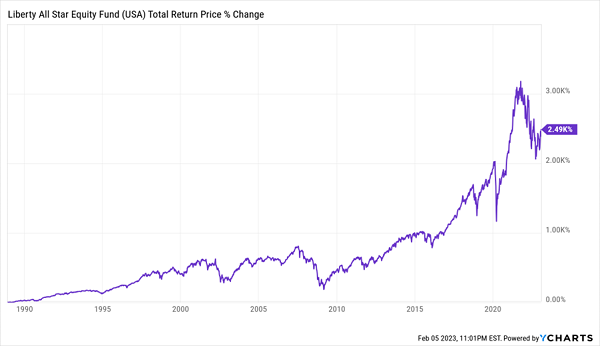Recent headlines have spurred some readers to write in about China—specifically what rising tensions between Beijing and Washington (no thanks to the former’s ham-fisted spy-balloon fiasco) might mean for their portfolios.
First up, we always need to bear in mind that stocks—and in particular my favorite way to hold stocks (through a high-yielding closed-end fund, or CEF)—really are a long-term investment. I know that sounds obvious, but it can be easy to forget when alarming headlines—a war or a pandemic, say—flash across our screens.
In other words, global chaos is really nothing new for stocks. The difference today is that we’re more connected than ever, so every move made by one of America’s adversaries is emphasized all the more. This is why stocks have posted an average annualized return of around 8.5% going back several decades.
Stocks Soar Through Recession, Pandemics and Inflation

But China’s latest move does call up the question of whether we’re better to own US or international stocks (or funds) these days. So let’s look at which way the wind is blowing here. Then we’ll discuss a 9.5%-yielding CEF I see as perfect for this market moment.
American or International Stocks?
A big question right now is whether the pullback in globalization we’re seeing means the end of foreign investing, especially in China. Will growing tensions add fuel to the fire, encouraging Chinese companies to look inward and abandon their global ambitions?
In short, the answer is no. Recently, Bloomberg cataloged a list of Chinese firms looking to expand internationally, thanks to growing co-operation with European partners. For example, you may have never heard of Zhejiang Sanhua Intelligent Controls Co., but they recently raised billions of American dollars by partnering with the SIX Swiss Exchange. And that’s one example of many.
So no, international stocks are not off the table for us dividend investors. But before you invest in an international stock or a popular overseas ETF like the Vanguard FTSE All-World Ex-US ETF (VEU), you should look closely at one critical indicator: the strength of the US dollar.
We can do that through an ETF called the Invesco US Dollar Bullish ETF (UUP), which tracks the strength of the greenback, the level of which is a good way to gauge whether foreign stocks are a buy or not. When UUP reaches highs, foreign stocks tend to sell off, which is why anyone who bought VEU when UUP peaked late last year has been outperforming America-focused funds, even though those are doing pretty well, too.
The Greenback’s High = Foreign Stocks’ Low

Of course, timing is everything, because holding VEU over the long term will mean underperforming the S&P 500 by a wide gap.
Foreign Stocks Are a Long-Term Loser

Because we’re long-term investors at Contrarian Outlook, we don’t try to time the currency or stock markets. Which is why I continue to recommend holding the bulk of your portfolio in proven US stocks with long-term histories of profits. Or better yet, the CEFs that hold them.
This CEF Gives You a 9.5% Yield on America’s Best Stocks
The Liberty All-Star Equity Fund (USA) is a good example. It’s been delivering strong gains and dividends for decades, but its yield is a lot bigger—a whopping 9.5% currently—even though it invests in many of the biggest S&P 500 stocks, including Amazon.com (AMZN), Apple (AAPL) and Microsoft (MSFT).
Strong Gains for the Long Haul

With USA, you get access to highly profitable US firms without the hassle of trying to time the US dollar. Plus you get a 9.5% income stream, which is more than five times as much as the average S&P 500 stock pays. (Though its total annual payout does vary somewhat, as management has a policy of paying 10% of its net asset value—NAV, or the per-share value of its portfolio—as dividends.)
Speaking of NAV, you’re getting a bit of a discount in disguise here. That’s because, as I write this, USA trades at an even level with its NAV. That’s unusual for CEFs, which often trade at discounts, and particularly big ones these days, due to the 2022 selloff. However, USA has traded at an average premium of just under 3% over the past year, so you’re still getting a deal here.
This Easy “Rinse and Repeat” Trade Delivers 9.1% Dividends (+ Gains)
Discounts and big dividends are the two main reasons you buy a CEF—ideally you move in when the discount is especially wide, then ride along as it closes, propelling the share price higher as it does. AND you collect these funds’ 7%+ dividends the entire time!
Then, when that discount flips to a premium, we sell and move to another deep-discounted CEF!
USA is a good example, but we crave a deeper discount sale to go along with our outsized payout. That’s why I urge you to buy the 5 CEFs I’ll share with you right here. They yield an outsized 9.1% on average and sport discounts so massive I expect 20%+ price upside from them in the next 12 months.
So you’ve got plenty of “ride-along” upside ahead as these discounts disappear, plus a massive 9.1% dividend, too!
Don’t miss this rare buy window. Click here and I’ll tell you more about these 5 bargain-priced 9.1%-paying CEFs. Plus I’ll give you the opportunity to download a Special Report that reveals their names, tickers, yields and their huge discounts to NAV, too!

Recent Comments